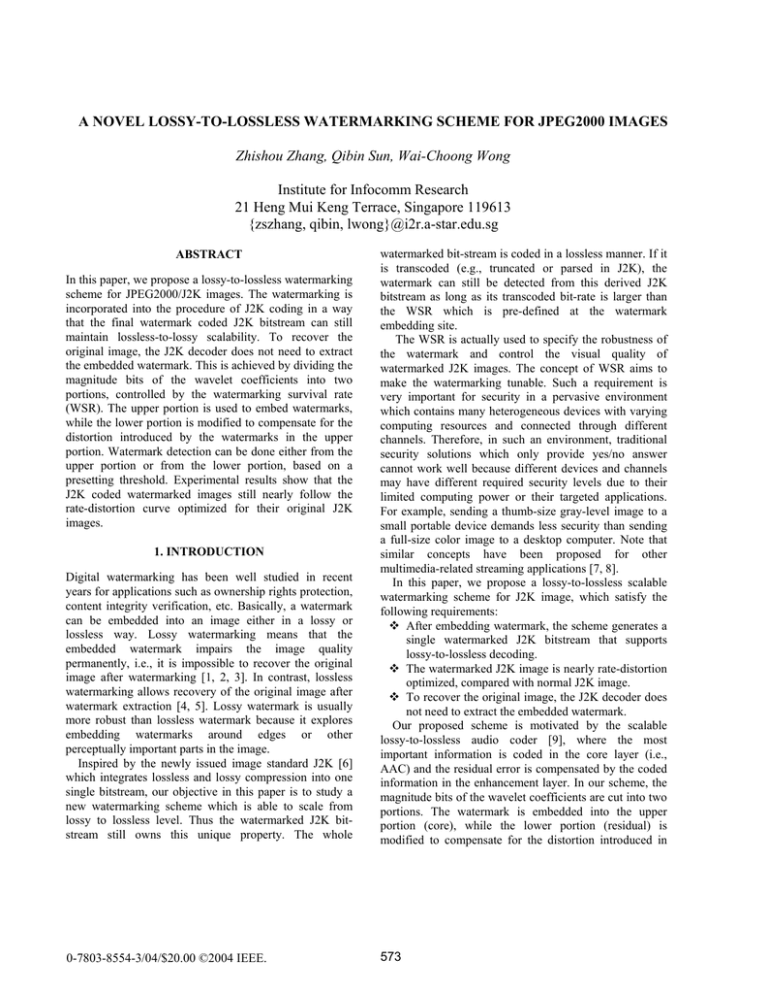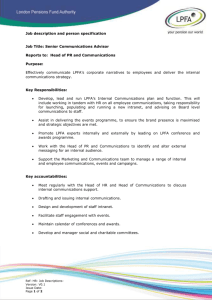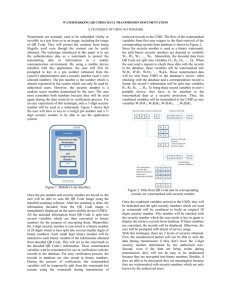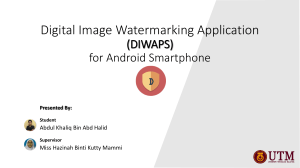A NOVEL LOSSY-TO-LOSSLESS WATERMARKING SCHEME FOR JPEG2000 IMAGES
advertisement

A NOVEL LOSSY-TO-LOSSLESS WATERMARKING SCHEME FOR JPEG2000 IMAGES
Zhishou Zhang, Qibin Sun, Wai-Choong Wong
Institute for Infocomm Research
21 Heng Mui Keng Terrace, Singapore 119613
{zszhang, qibin, lwong}@i2r.a-star.edu.sg
Digital watermarking has been well studied in recent
years for applications such as ownership rights protection,
content integrity verification, etc. Basically, a watermark
can be embedded into an image either in a lossy or
lossless way. Lossy watermarking means that the
embedded watermark impairs the image quality
permanently, i.e., it is impossible to recover the original
image after watermarking [1, 2, 3]. In contrast, lossless
watermarking allows recovery of the original image after
watermark extraction [4, 5]. Lossy watermark is usually
more robust than lossless watermark because it explores
embedding watermarks around edges or other
perceptually important parts in the image.
Inspired by the newly issued image standard J2K [6]
which integrates lossless and lossy compression into one
single bitstream, our objective in this paper is to study a
new watermarking scheme which is able to scale from
lossy to lossless level. Thus the watermarked J2K bitstream still owns this unique property. The whole
watermarked bit-stream is coded in a lossless manner. If it
is transcoded (e.g., truncated or parsed in J2K), the
watermark can still be detected from this derived J2K
bitstream as long as its transcoded bit-rate is larger than
the WSR which is pre-defined at the watermark
embedding site.
The WSR is actually used to specify the robustness of
the watermark and control the visual quality of
watermarked J2K images. The concept of WSR aims to
make the watermarking tunable. Such a requirement is
very important for security in a pervasive environment
which contains many heterogeneous devices with varying
computing resources and connected through different
channels. Therefore, in such an environment, traditional
security solutions which only provide yes/no answer
cannot work well because different devices and channels
may have different required security levels due to their
limited computing power or their targeted applications.
For example, sending a thumb-size gray-level image to a
small portable device demands less security than sending
a full-size color image to a desktop computer. Note that
similar concepts have been proposed for other
multimedia-related streaming applications [7, 8].
In this paper, we propose a lossy-to-lossless scalable
watermarking scheme for J2K image, which satisfy the
following requirements:
After embedding watermark, the scheme generates a
single watermarked J2K bitstream that supports
lossy-to-lossless decoding.
The watermarked J2K image is nearly rate-distortion
optimized, compared with normal J2K image.
To recover the original image, the J2K decoder does
not need to extract the embedded watermark.
Our proposed scheme is motivated by the scalable
lossy-to-lossless audio coder [9], where the most
important information is coded in the core layer (i.e.,
AAC) and the residual error is compensated by the coded
information in the enhancement layer. In our scheme, the
magnitude bits of the wavelet coefficients are cut into two
portions. The watermark is embedded into the upper
portion (core), while the lower portion (residual) is
modified to compensate for the distortion introduced in
0-7803-8554-3/04/$20.00 ©2004 IEEE.
573
ABSTRACT
In this paper, we propose a lossy-to-lossless watermarking
scheme for JPEG2000/J2K images. The watermarking is
incorporated into the procedure of J2K coding in a way
that the final watermark coded J2K bitstream can still
maintain lossless-to-lossy scalability. To recover the
original image, the J2K decoder does not need to extract
the embedded watermark. This is achieved by dividing the
magnitude bits of the wavelet coefficients into two
portions, controlled by the watermarking survival rate
(WSR). The upper portion is used to embed watermarks,
while the lower portion is modified to compensate for the
distortion introduced by the watermarks in the upper
portion. Watermark detection can be done either from the
upper portion or from the lower portion, based on a
presetting threshold. Experimental results show that the
J2K coded watermarked images still nearly follow the
rate-distortion curve optimized for their original J2K
images.
1. INTRODUCTION
the upper portion. Therefore, a decoder can recover the
original image without the need to extract the watermark.
The cutting point of the magnitude bits is controlled by a
user specified WSR. Given the WSR, the cutting points of
all wavelet coefficients can be accurately allocated by
running EBCOT [6].
This paper is organized as follows: Section 2 gives the
system overview; Section 3 and Section 4 describe the
detailed watermark embedding and extraction methods
respectively. Experimental results are given in Section 5.
Finally, Section 6 concludes the paper.
2. SYSTEM OVERVIEW
Fig. 1 illustrates watermark embedding in our proposed
scheme. It is integrated with the J2K encoding process.
Given the original image, the WSR and the watermark,
we divide the magnitude bits of wavelet coefficients into
two portions: core and residual. The watermark is
embedded into the core portion, while the residual portion
is modified to compensate for the distortion introduced by
the watermark embedded in core portion. After that, the
two portions are concatenated together and sent to J2K
encoding, resulting in one single watermarked J2K
bitstream that supports lossy-to-lossless decoding.
Watermark detection is the reverse process of
watermark embedding. Similarly, the magnitude bits of
wavelet coefficients are divided into two portions. We
compute the correlation between the watermark and either
the upper portion or the lower portion of the coefficients,
which is then compared with a threshold to decide
whether the watermark is present. In addition, a decoder
can recover the original image without the need to extract
the embedded watermark, as described in Section 4.
Firstly, using 5x3 reversible wavelet transform [6], we
decompose the original image N times to obtain multiresolution representations or subbands of the image: HLn,
LHn, HHn and LLN ( n = 1,2, K, N ). HLn and LHn
subands are used to embed watermarks.
Secondly, WSR is used to search for the optimized
truncation points by running the J2K EBCOT process [6].
For the same WSR value, the corresponding truncation
point might be different for different codeblocks. If
necessary, the truncation point is adjusted to stay at the bit
plane boundary. After that, the truncation point is used as
the dividing point to split magnitude bits of wavelet
coefficients. All magnitude bits above the truncation point
form the upper portion (U bits), while the rest form the
lower portion (L bits). In particular, each wavelet
coefficient I i is divided into two numbers u i and d i such
that
I i = ui × 2 L + di , sign(I i ) = sign(ui ) = sign(d i )
Thirdly, we compute the value ∂ i that should be
added to u i in order to embed the watermark.
α × ui × wi + 0.5 if wi ≥ 0
∂i =
α × ui × wi − 0.5 if wi < 0
where
α
is a fixed scaling factor between 0 and 1 ( α =
0.2 in our experiment). By using u i , a visual masking
factor is implicitly utilized. For instance, for larger
coefficients, the watermark will be embedded with more
energy to enhance watermark robustness without
degrading perceptual quality. However, adding ∂ i to u i
may cause overflow or change of sign for u i , which may
affect the J2K coding efficiency. So, we need to shape it
to a new value ∂ ′i that does not cause any overflow or
change of sign. The ∂ ′i is an integer with the largest
magnitude that satisfies the following conditions:
∂ ′i ≤ ∂ i ,
sign(∂ i ) = sign(∂ ′i ) ,
ui + ∂ ′i ≤ 2 − 1 , sign(ui + ∂′i ) = sign( I i ) ,
U
Fig. 1. Diagram of watermark embedding
3. WATERMARK EMBEDDING
di − ∂′i × 2L ≤ 2L+λ −1, sign(di − ∂′i × 2L ) = sign(Ii )
Once the value of ∂ ′i is decided, we can embed the
watermark wi to u i and obtain
ui' = ui + ∂ ′i . On the
We assume the watermark is a random noise sequence of
real numbers wi ∈ W , where i = 1,2, K , M , and M
other hand, the introduced distortion is compensated by
is the length of the watermark sequence. It is normal
distributed with zero mean and unit variance. We adopt
the spread spectrum watermarking technique, though
other watermarking techniques may also be applicable.
u i' has U magnitude bits and d i' has L + λ magnitude
bits, where λ is the number of extra bits to accommodate
modifying d i , such that d i = d i − ∂ ′i × 2 . After that,
'
574
L
d i' . Lastly, the sign bit of I i , U magnitude
overflow of
bits of u i' and L + λ
magnitude bits of d i' are
concatenated as one coefficient I = u × 2
'
i
'
i
L+λ
+d ,
'
i
which is then sent to EBCOT for encoding. The final
output is the J2K coded watermarked image.
4. WATERMARK DETECTION
Given a watermarked J2K image, the detector still needs
two other inputs for the watermark detection: WSR and
the watermark. WSR is used to determine the dividing
point for each coefficient from the J2K decoding process,
for recovering the original image and correctly correlating
watermarks.
Assume we have obtained the sign-magnitude
representation of each coefficient
into
I
*
i
two
numbers
=u ×2
*
i
L+λ
+d
u i*
I i* , it is then divided
and
d i*
such
*
i
that
and
sign ( I i* ) = sign ( u i* ) = sign ( d i* ) . Then we calculate
the correlation z between
u i* and wi as follows
1 M *
∑ u i × wi
M i =1
By comparing the correlation z with a predefined
threshold Thrz [10], the detector can decide whether the
watermark sequence W is present in the image.
The above discussion is for watermark detection,
where only u i* is used (the watermark detection from d i*
can be derived in a similar way). To recover the original
image, we have to use both u i* and d i* . Suppose there is
z =
no introduced distortion, i.e., u i* = u i' and d i* = d i' , the
recovered coefficient I i′′ can be computed as follows,
I i′′ = u i* × 2 L + d i* = u i' × 2 L + d i'
= (u i + ∂ ′i ) × 2 L + (d i − ∂ ′i × 2 L )
= ui × 2 L + d i = I i
Note that WSR is used to recover the original image
and correctly correlate the watermarks by accurately
allocating the dividing points for each coefficient.
Therefore, whether we can get the exact same dividing
points as those done at the embedding site plays a key role
in our scheme. We observed that actually EBCOT works
very well in accurately allocating the dividing points by
testing various types of images, assuming no distortion is
introduced into the coded watermarked bitstream. Even if
there was an exception where EBCOT failed in accurately
allocating those points, we could solve this problem by
inserting some special markers (>0xFF8F) into the
bitstream to flag them. For the cases where some
distortion exist, i.e.,
u i* ≠ u i' and d i* ≠ d i' , though we
cannot recover the original image, the watermark can still
be detected. In addition, the watermark embedded in
upper portion and lower portion can still cancel each other
to a certain extent, thereby achieving better image quality.
5. EXPERIMENTAL RESULTS
In order to evaluate the proposed scheme, we have
implemented the scheme and measured PSNR, detection
response and file size of the watermarked J2K image.
Firstly, we test the compatibility of our scheme with the
standard J2K decoder, i.e., using the standard J2K
decoder to decode our coded watermarked J2K image. Fig.
2 shows the original “Café” image (gray level, 1024x1280
pixels, 8 bits/pixel) and that decoded by a standard J2K
decoder. The image is decomposed into 4 resolution
levels, and Subband HL2 is used for watermark
embedding. The measured PSNR is about 40dB.
Fig. 3 compares the PSNR of the normal J2K image
and the watermarked J2K images (WSR = 1.5bpp and
3.5bpp) when they are truncated to different rates. It
shows that the PSNR curve of the watermarked images
closely follows that of the normal J2K images. The only
exception is at the point when truncation rate approaches
the WSR, where the image quality is lower than the
normal J2K image. This is due to the absence of
compensation from the lower portion, as all compensated
bit planes have been completely truncated. Therefore, the
watermarked J2K image is nearly rate-distortion
optimized, as compared with the normal J2K images.
Fig. 4 compares the detection response (or correlation
value) of the watermarked J2K images (WSR = 1.5bpp
and 3.5bpp) when they are truncated to different rates.
When the truncation bit rate is greater than 0.2, the
detection response is always above the corresponding
threshold, which indicates the presence of the claimed
watermark. When the truncation rate is very small
(<0.2bpp), the detection response drops drastically,
thereby being unable to detect the watermark. Another
interesting point is that, the detection response for
watermark with WSR=1.5bpp drops much slower than
that with WSR = 3.5bpp. That is to say, a watermark
embedded with a smaller WSR is more robust.
Fig. 5 shows the detection responses when the
watermarked image is detected against 200 different
watermark sequences, one of which (50th) was indeed
embedded in the image. As seen from the graph, it can
effectively detect the right watermark using the computed
threshold value. The detection response when WSR=
1.5bpp is smaller than that when WSR=3.5bpp. This is
575
6. REFERENCES
because u i is smaller when WSR is smaller, thus, the
watermark is embedded with less energy, resulting in
smaller detection response.
Fig. 6 compares the size of the normal J2K image and
the size of the watermarked J2K images with different
WSRs. Our experiment shows that the size of
watermarked J2K images is about 2%~4% larger than the
size of the normal J2K images.
5. CONCLUSION
In this paper, we have presented a lossy-to-lossless
watermarking scheme for J2K images. Our contribution
includes: 1.) Generating a single J2K coded watermarked
bitstream that supports lossy-to-lossless decoding; 2.) The
original image can be recovered without the need to
extract the watermark. 3.) Quality of protection and
watermark robustness level is quantitatively controlled by
a parameter called the watermark survival rate (WSR).
Our experiments confirmed that the watermarked J2K
image is nearly rate-distortion optimized, the decoder can
recover the original image, the watermark can be detected
effectively, and it is robust against code stream truncation.
[1] P.-C. Sun, H.-J. M. Wang and C.-C. Jay Kuo, “An Integrated
Approach to Image Watermarking and JPEG-2000
Compression”, Journal of VLSI Signal Processing, vol 27,
pp.35-53, 2001
[2] R. Grosbois, T. Ebrahimi, “Watermarking in the JPEG2000
domain”, MMSP2001, October 3-5, 2001
[3] W. Zeng and S. Lei, “Transform Domain Perceptual
Watermarking with Scalable Visual Detection – A Proposal for
JPEG2000”, ISO/IEC JTC/SC29/WG1 N759, March 1998
[4] M. Goljan, J. Fridrich and R. Du, “Distortion-Free Data
Embedding”, in 4th Information Hiding Workshop, Aprial 2001
[5] Z. Ni, Y. Q. Shi, N. Ansari, W. Su, Q. Sun and X. Lin,
“Robust Lossless Image Data Hiding”, submitted to ICME 2004
[6] “JPEG2000 Part I Final Draft International Standard”,
ISO/IEC JTC 1/SC29/WG1 N1876, August 2000
[7] Q. Sun, S.-F. Chang, M. Kurato and M. Suto, “A
Quantitative Semi-Fragile JPEG2000 Image Authentication
System”, ICIP 2002
[8] C. S. Ong, K. Nahrstedt and W. Yuan, “Quality of Protection
for Mobile Multimedia Applications”, ICME 2003
[9] R. Yu, X. Lin, S. Rahardja and C. C. Ko, “A Scalable Lossy
To Lossless Audio Coder For MPEG-4 Lossless Audio Coding”,
ICASSP 2004
[10] H. Inoue, A. Miyazaki, T. Katsura, “An Image
Watermarking Method Based On The Wavelet Transform”, ICIP,
1999
(a) Original image
(b) watermarked image, WSR=1.5bpp
Fig. 2 Original and Wmk image decoded by standard decoder
Fig. 4 Correlation Vs. Truncation Rates
Fig. 5 Correlation Vs. different
watermarked sequences
576
Fig. 3 Image PSNR Vs. Truncation Rate
Fig. 6 Original J2K file size Vs.
watermarked J2K file size for various
WSRs







